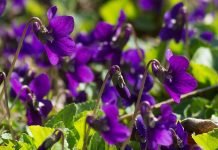Peaches (Prunus persica) and nectarines (P. persica) are ideal for small garden spaces. Firstly because they are self-fertile, meaning they don’t require another tree for pollination. Secondly, there are compact forms of peaches that can successfully be grown in pots, making them suitable for a sunny patio, courtyard or balcony. These varieties rarely growing higher than 1m when grown in a pot, and require minimal pruning.
Peaches and nectarines are best grown as a fan on a warm south or south facing wall. Peaches can be grown as free-standing bushes in very favorable sites, but nectarines will struggle. Due to their slightly tender nature, both peaches and nectarines can also successfully be grown in glasshouses but will require diligent watering. Avoid a heated greenhouse as they require a period of dormancy.
Avoiding frost pockets is another vital requirement as their early spring blossom can easily become damaged. A sheltered position will help prevent the leaves and fruit becoming damaged, and exposure to rain will create problems with peach leaf curl.

The soil should be well-drained, yet at the same time have plenty of humus content to help retain moisture. Peach trees will struggle in light, shallow soils, meaning that any underlying pans should be broken up prior to planting and plenty of organic matter incorporated into the planting area.
A container grown peach tree can be planted at anytime of the year, but avoid planting during the summer as it will require copious watering. Bare root trees are usually healthier plants as they are not rootbound. The best time to plant is late autumn as the soil is still warm and it means they have more chance to establish themselves before the big push in early spring.

Pruning peaches and nectarine
It is best to buy a partially trained two or three-year old fan from a garden centre or nursery as this will save both time and money. There should be at least 8 branches on the partially-trained fan. These should be spread out evenly over the wall-space, with four branches on each side and tied to canes, attached to wires on the wall.
1. Pruning should begin in mid-February to early March when the plant is in growth. Leave all the swollen, fat buds that will become this years flowers and subsequently the fruit. Identify the vegetative buds or shoots as they will bear next year’s crop. Leave one new shoot towards the base of the branch and another one halfway up the branch. The shoot at the base will be used for next year’s replacement. The second shoot will be used as a back-up in case the shoot near the base fails. The terminal bud (in the tip of the branch) can also be left. All other emerging shoots should be removed – except for those surrounding the fruit buds / flowers.

2. The new shoots should be tied in as they grow. In early June, pinch back all secondary growth to one leaf. The shoots that were left in step one should be pinched back to about six leaves. The terminal bud can be allowed to continue.
3. After harvesting, in late summer, prune out some of the older wood and some of the laterals that fruited last year. Tie in some of the new growth from the current year as replacements as these will be the branches that produce your crop the following year. Remove any excessive shoots that are overcrowding the fan and also any diseased wood.growing if there is enough room.

Harvesting, eating and storing
1. Ripe fruits are fully colored and the flesh close to the stem is soft. Once ready, they stay pristine in a cool place only for several days. They can be picked slightly under-ripe and left to ripen in a fruit bowl, but they’ll lack the same juicy sweetness that tree ripened fruit possess.
2. The fruit do not ripen uniformly at the same time. Check fruit regularly and pick as they ripen.
3. Peaches and nectarines do not keep well in storage, so best eaten fresh or bottled for winter.

Pests and problems
– Frost damage to blossoms in spring can be avoided with protective covers;
– Netting will protect the fruit from the birds and wasps in summer;
– Peach leaf curl can be a primary disease affecting the trees.



























